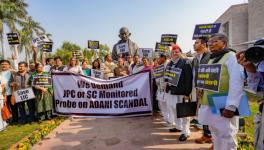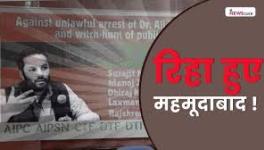On a Wing and a Prayer, Congress Woos Uttar Pradesh Voters

Representational Image. Image Courtesy: PTI
Earlier this month, a convoy of Congress party leaders stopped at a tea stall near the historical Chhota Imambara in the densely populated Muslim locality of Hussainabad, Lucknow. There, the leaders alighted and interacted with locals, the majority of whom were Muslims, and discussed the civic issues of the locality.
This visit was one of numerous; a part of the Congress party’s plan to win back the trust of the Muslim community, which distanced itself from the grand old party after the demolition of the Babri Masjid on 6 December 1992. Muslim disenchantment has proven costly to Congress, as it has diminished in politically significant Uttar Pradesh and in national politics.
The drift of the Muslim community’s electoral support for the Congress party first started during the late 1980s, during the rise of Mandal politics. Soon, it saw their loyalty shift towards the Samajwadi Party founded by Mulayam Singh Yadav in 1992.
At the same time, Kanshi Ram’s Bahujan Samaj Party (BSP) also rose, and it weaned Dalit voters away from the Congress. In the 1993 Assembly election, the Samajwadi Party and BSP joined hands and emerged as a strong political force against the communal politics of the Bharatiya Janata Party (BJP).
However, the Samajwadi Party-BSP alliance broke after the infamous guest house incident in 1995. Still, the Dalits and Muslims kept their loyalty to either party intact. That is why they could successively form governments in the politically significant state between 1995 and 2012, which kept the Congress out of power for more than three decades.
Since then, the Congress’s best performance in Uttar Pradesh was in the 2009 general election when it won 21 out of 80 parliamentary seats. It is widely believed that Muslim voters supported Congress in that election because Mulayam Singh Yadav had inducted Kalyan Singh, a hardline Hindutva leader who was the chief minister when the Babri masjid was demolished.
However, the political paradigm in Uttar Pradesh changed dramatically again in 2013–14, with the arrival of Hindutva leader and then Gujarat chief minister, Narendra Modi, on the national political stage. The Samajwadi Party and BSP have been weakening in every election since then. In the strong wave of nationalism and Hindutva, a large section of the backward classes and Dalits jumped from both the parties and supported the saffron party.
There are now stirrings of change again—while the BSP’s vote share in the 2022 Assembly election declined by over 9%, the Samajwadi Party gained over 10% of its vote share, lost in the 2017 election. However, the Samajwadi’s gains were not enough to unseat the Yogi Adityanath government. In the 2017 Assembly election, the Samajwadi Party had lost over 7% of its vote share, and the BSP had lost close to 4%. In the 2017 and 2022 elections, the BJP gained close to 25% and 3% votes respectively.
Such electoral outcomes indicate that the so-called Mandal parties’ electoral experiments have yielded limited results or failed to halt the BJP’s juggernaut in Uttar Pradesh.
This has enthused the Congress party enough to believe that there is a deep sense of disillusionment among the Muslims towards the Samajwadi Party. At the same time, the Congress also seems to believe that a sizeable section of Dalit voters has swung towards the BJP because it wants to see the Samajwadi Party out of power. This may or may not be true, for the 2022 election result indicates that the increase in the Samajwadi Party’s vote share came from a cross-section of voters, including the Muslims, elite castes, backward groups and the Dalits.
That said, the BSP supremo Mayawati is rarely seen on the ground, and the Dalit-Bahujan social movement has weakened in Uttar Pradesh. The Jatavs, the BSP’s electoral mainstay, are a bulk of the Scheduled Caste population in Uttar Pradesh. However, members of other Dalit communities (around 12% of the state population), have, of late, been swayed by Hindutva. Besides, especially in rural areas, the dominant backward classes, such as the Yadavs, Jats or Kurmis, are those the Dalits identify as their oppressors.
This inter-caste rivalry has been the biggest obstacle to forming a formidable alliance between the Dalits and the other backward castes (OBCs) in Uttar Pradesh. Sadly, little has been done to counter these contradictions between social groups which otherwise share socio-economic affinities that could bring them together politically. According to the Congress party, the Dalit voter’s swing towards the BJP was real, but has lost its sheen as economic hardships and atrocities have continued unabated.
It is these gaps that the Congress party is now trying to fill with its on-ground campaign. It believes that it can penetrate successfully among the Muslim community, which would draw the Dalit voters disenchanted with Hindutva also into its fold. While the formulation would test the limits of Hindutva, the question is, in this strongly polarised environment, will pitching for Dalit-Muslim solidarity work on the ground?
Here, the Congress party hopes that pushing for reservations as a right of the backwards, Dalits and Muslims, promising to protect the Constitutional right to equality and justice, and highlighting the rising atrocities against the Dalits and the Muslims will become the glue to draw the support of these social groups before the 2024 Lok Sabha polls.
That is why the party has been holding roadside meetings at tea stalls and at religious sites where people gather to discuss livelihood issues and concerns of their respective communities. The Congress hopes to create a narrative that will remind people that until 1989, the Muslims and Dalits were in its fold, and the communal forces were then at bay. Until the 1990s, the BJP could win only two seats in Parliament. But once they lent their support to other parties, the situation changed dramatically.
That said, Muslim voters have solidly supported the Samajwadi Party in many parts of Uttar Pradesh. Further, it is a member of the INDIA alliance, contesting against the BJP in the next general election, of which the Congress party gets the most votes. Would not the Congress and Samajwadi Party be battling over the same sets of voters? When the Congress tried to steer women voters in its favour in 2022, the move was welcomed by many, but did not result in electoral benefits.
Besides, the Samajwadi Party is the principal opposition party in Uttar Pradesh with 113 lawmakers in the 403-seat Assembly. In 2022, Muslim voters overwhelmingly picked the Samajwadi Party, despite the silence of party chief and former chief minister Akhilesh Yadav, during the anti-Citizenship (Amendment) Act protests in 2019.
That year, the police-led crackdown in many parts of the state saw numerous Muslim protesters killed and social activists incarcerated. At that time, Congress general secretary Priyanka Gandhi had visited the victim’s families in various towns. But the Congress did not reap any electoral dividends from this, either. It was limited to two Assembly seat wins in Uttar Pradesh.
Perhaps the silver lining for the Congress is its enhanced votes in the municipal election, especially in the Muslim-dominated seats in Moradabad and Lucknow. That has made the state Congress enthusiastic about winning back Muslims' trust--a hope boosted by Rahul Gandhi’s Bharat Jodo Yatra, which sent the message that the Congress could be a strong contender against the BJP in 2024.
At least during the yatra, Gandhi could create the perception that his party is more vocal in backing the concerns of the Muslims than any other. Indeed, it hopes to garner a fourth each of Muslim and Dalit votes in Uttar Pradesh next year, which is a tall order.
The author is an independent journalist. The views are personal.
Get the latest reports & analysis with people's perspective on Protests, movements & deep analytical videos, discussions of the current affairs in your Telegram app. Subscribe to NewsClick's Telegram channel & get Real-Time updates on stories, as they get published on our website.
























